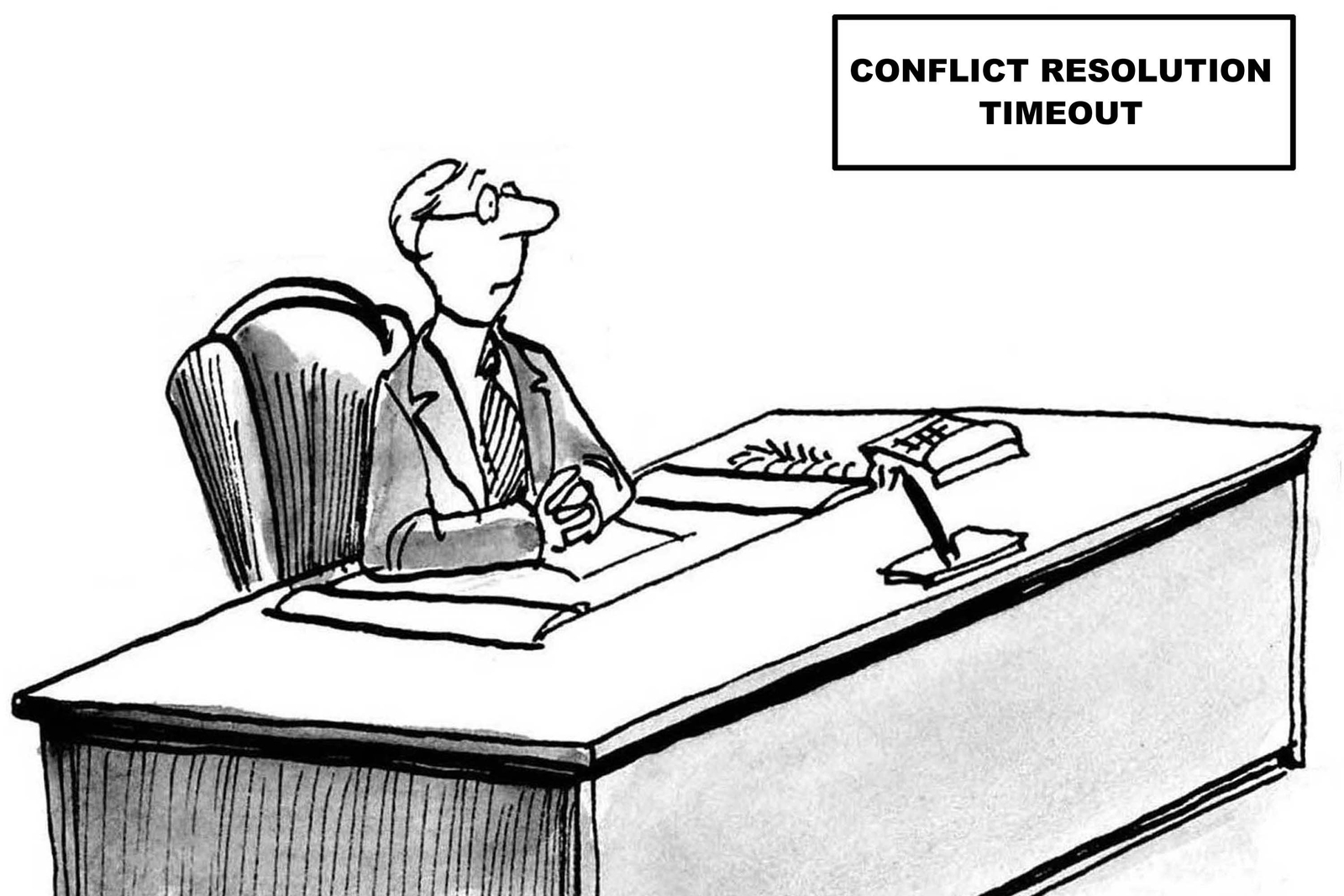
Conflict Resolution: Getting Along in the Workplace
START THIS COURSE TODAYCourse Overview
This course will give you the tools that will help you resolve conflict successfully and produce a win-win outcome.

Knowledge Checks
Digital Workbook
Certificate
Tutor Support
Course Value $350
Course Description
Many people see conflict as a negative experience. In fact, conflict is a necessary part of our personal growth and development. Think of when you were trying to choose your major in college, for example, or trying to decide between two jobs. However, conflict becomes an issue when the people involved cannot work through it. They become engaged in a battle that does not result in growth. When this type of conflict arises, negative energy can result, causing hurt feelings and damaged relationships.

-
MODULE 1 • 3 LESSONS
COURSE OVERVIEW
• Learning Objectives + Exercise 1
• Pre-Assignment A Conflict Effectiveness Benchmark
• Pre-Course Assessment
-
MODULE 2 • 4 LESSONS
DEFINING CONFLICT
• Defining Conflict
• Defining Conflict + Exercise 2
• Assumptions
• Positives and Negatives + Exercise 3
-
MODULE 3 • 5 LESSONS
TYPES OF CONFLICT
• Types of Conflict Part One
• Types of Conflict Part Two
• Inner Conflict
• Interpersonal Conflict
• Group Conflict
-
MODULE 4 • 4 LESSONS
OPEN CONFLICT VS. HIDDEN CONFLICT
• Open Conflict vs. Hidden Conflict
• Dealing with Conflict
• Open Conflict
• Hidden Conflict
-
MODULE 5• LESSONS
SPONTANEOUS AND REFLECTIVE BEHAVIOUR
• Spontaneous and Reflective Behaviour
• Spontaneous and Reflective Behaviour Part Two
• Exploring Behaviours
-
MODULE 6 • 11 LESSONS
THE JOHARI WINDOW
• The Johari Window
• Understanding the Johari Window
• Self-Disclosure with the Johari Window
• My Window + Exercise 4
• Case Study: Spontaneous and Reflective Behaviours
• Case Study: Spontaneous and Reflective Behaviours Part Two
• Case Study: Spontaneous and Reflective Behaviours Part Three
• Case Study: Spontaneous and Reflective Behaviours Part Four
• Case Study: Spontaneous and Reflective Behaviours Part Four
• Questions + Exercise 5
• Questions + Exercise 6
-
MODULE 7 • 24 LESSONS
STAGES OF CONFLICT
• Stages of Conflict
• The Five Stages of Conflict
• Latent Conflict
• Perceived Conflict
• Felt Conflict
• Manifest Conflict
• Conflict Aftermath
• Conclusion
• Stage 1: Mild Difference
• Stage 2: Disagreement
• Stage 3: Dispute
• Stage 4: Campaign
• Stage 5: Litigation
• Stage 6: Fight and/or War
• Conflict Outcomes
• Win-Lose
• Win-Win
• Strategies for Dealing with Conflict
• Win/Lose Strategy
• Win/Lose Strategy Part Two
• Lose/Lose Strategy
• Results of Win/Lose and Lose/Lose Strategies
• Win/Win Strategy
-
MODULE 8 • 4 LESSONS
CREATING THE WIN/WIN
• Creating the Win/Win
• Case Study
• Case Study Part Two
• Instructions + Exercise 7
-
MODULE 9 • 9 LESSONS
CONFLICT RESOLUTION STYLE QUESTIONNAIRE
• Conflict Resolution Style Questionnaire
• The Questionnaire + Exercise 8
• Score Sheet + Exercise 9
• The Conflict Grid
• Pros and Cons + Exercise 10
• Authoritative Command/Competitive + Exercise 11
• Smoothing + Exercise 12
• Compromising + Exercise 13
• Problem-Solving + Exercise 14
-
MODULE 10 • 13 LESSONS
THE ROLE OF COMMUNICATION IN CONFLICT RESOLUTION
• The Role of Communication in Conflict Resolution
• The Communication Chain
• Speaker’s Words
• Speaker’s Facial Expressions
• Speaker’s Tone of Voice
• Other Body Language
• Other Barriers
• Paradigms
• Education
• Assumptions
• Establishing Positive Intent
• Making Connections + Exercise 15
• Accepting Differences
-
MODULE 11 • 7 LESSONS
ACTIVE LISTENING SKILLS
• Active Listening Skills
• Active Listening Skills Part Two
• Active Listening Skills Part Three
• Responding to Feelings
• Reading Cues
• Demonstration Cues
• Tips for Becoming a Better Listener
-
MODULE 12 • 5 LESSONS
PARAPHRASING SKILLS
• Paraphrasing Skills
• What Is Paraphrasing
• Case Study
• Summary Questions
• Making Connections + Exercise 16
-
MODULE 13 • 9 LESSONS
POWERFUL QUESTIONS
• Powerful Questions
• Asking Questions
• Open Questions
• Handy Questions
• Making Connections + Exercise 17
• Making Connections + Exercise 18
• Probing Techniques
• Probing Techniques, Part Two
• Probing Techniques, Part Three
-
MODULE 14 • 5 LESSONS
BODY LANGUAGE
• Body Language
• Body Language Basics
• Body Language Basics Part Two
• Making Connections + Exercise 19
• Making Connections + Exercise 20
-
MODULE 15 • 2 LESSONS
PRE-ASSIGNMENT REVIEW
• Pre-Assignment Review
• Pre-Assignment Review
-
MODULE 16 • 6 LESSONS
The Conflict/Opportunity Test
• The Conflict/Opportunity Test
• The Conflict/Opportunity Test Part Two
• Skills Test + Exercise 21a
• Situation Two + Exercise 21b
• Situation Three + Exercise 21c
• Situation Four + Exercise 21d
-
MODULE 17 • 13 LESSONS
CONFLICT AND ITS RESOLUTION
• Conflict and Its Resolution
• Visualizing Conflict
• Conflict Resolution Process
• Assumptions when Using the Conflict Resolution Process
• Hands-On Steps
• Hands-On Steps Part Two
• Hands-On Steps Part Three
• Template
• A Strategy for Conflict Resolution
• Phase Two: Identify the Common Goal
• Phase Three: Identify and Rate Underlying Needs
• Phase Four: Explore Assumptions
• Phase Five: Brainstorm Solutions and Choose One
-
MODULE 18 • 26 LESSONS
HELPING OTHERS THROUGH CONFLICT
• Helping Others Through Conflict
• Preparation Tips
• Preparation Tips Part Two
• Preparation Tips Part Three
• Give It a Name
• Check for Agreement
• Avoid Process Battles
• Echo
• Keep the Group on Track
• Hold Them to Their Word
• Encourage and Compliment
• Deal With/Accept/Legitimise/Defer
• Don’t Be Defensive
• Use Your Body Language
• Keep It Simple
• Setting Norms
• Sample Norms
• Using Norms
• Sample Survey
• Coaching Through Conflict
• Competing Issues
• Managing Your Emotions + Exercise 22
• The Positive Effect
• Fifteen Steps for Dealing with Upset People
• Five Tips for Dealing with Difficult People
• Six Steps for Dealing with Angry People
-
MODULE 19 • 5 LESSONS
A PERSONAL ACTION PLAN
• A Personal Action Plan
• Starting Point + Exercise 23a
• Where I Want to Go + Exercises 23b
• How I Will Get There + Exercise 23c
• Summary
-
MODULE 20 • 3 LESSONS
WRAPPING IT UP
• Recommended Reading List
• Post-Course Assessment
• Digital Workbook Submission
Further Your Learning Journey
Connect your SMART Mind. SMART Body. and SMART Soul. Further your learning with other related resources and courses.


